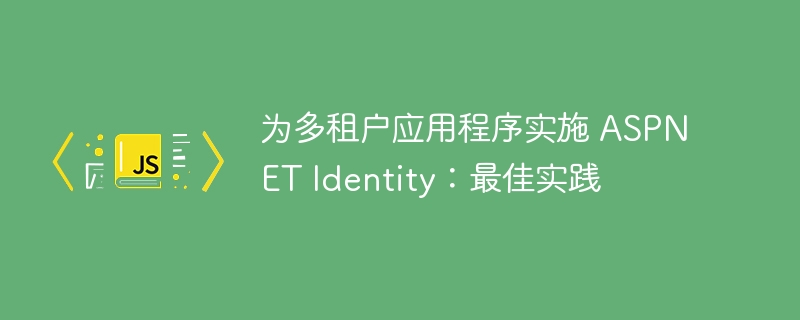
构建多租户应用程序带来了独特的挑战,特别是在管理跨多个租户的用户身份验证和授权时。在本文中,我将引导您了解如何在多租户环境中实现 asp.net identity,同时遵循最佳实践以确保可扩展性、安全性和可维护性。
多租户应用程序允许多个组织(租户)使用应用程序的同一实例,每个租户的数据与其他租户隔离。这种架构对于扩展和成本分摊非常有效,但在处理用户身份验证和授权时需要特别考虑。
asp.net identity 是一个用于处理身份验证和用户管理的灵活框架。要使其适应多租户设置,您需要:
在多租户应用程序中,每个用户必须与特定租户关联。您可以通过添加 tenantid 属性来修改 asp.net identity user 模型来跟踪用户所属的租户。
public class applicationuser : identityuser
{
public string tenantid { get; set; }
}
接下来,通过确保基于 tenantid 过滤查询来扩展 identitydbcontext 以支持特定于租户的数据。
public class applicationdbcontext : identitydbcontext<applicationuser>
{
public applicationdbcontext(dbcontextoptions<applicationdbcontext> options)
: base(options) { }
protected override void onmodelcreating(modelbuilder builder)
{
base.onmodelcreating(builder);
// add a global query filter to isolate data by tenant
builder.entity<applicationuser>().hasqueryfilter(u => u.tenantid == getcurrenttenantid());
}
private string getcurrenttenantid()
{
// implement logic to retrieve the current tenant's id, e.g., from the request or context
return tenantresolver.resolvetenantid();
}
}
为了确保每个用户与正确的租户关联,您需要一个租户解析器来确定当前请求与哪个租户相关。这可以基于子域、url 段或自定义标头。
public static class tenantresolver
{
public static string resolvetenantid()
{
// example: resolve tenant from subdomain or url segment
var host = httpcontext.current.request.host.value;
return host.split('.')[0]; // assuming subdomain is used for tenant identification
}
}
在多租户应用程序中,必须确保用户只能使用其特定于租户的凭据进行身份验证。自定义登录逻辑以在身份验证期间检查tenantid。
public class customsigninmanager : signinmanager<applicationuser>
{
public customsigninmanager(usermanager<applicationuser> usermanager,
ihttpcontextaccessor contextaccessor,
iuserclaimsprincipalfactory<applicationuser> claimsfactory,
ioptions<identityoptions> optionsaccessor,
ilogger<signinmanager<applicationuser>> logger,
iauthenticationschemeprovider schemes,
iuserconfirmation<applicationuser> confirmation)
: base(usermanager, contextaccessor, claimsfactory, optionsaccessor, logger, schemes, confirmation)
{ }
public override async task<signinresult> passwordsigninasync(string username, string password, bool ispersistent, bool lockoutonfailure)
{
// resolve tenant before signing in
var tenantid = tenantresolver.resolvetenantid();
var user = await usermanager.findbynameasync(username);
if (user == null || user.tenantid != tenantid)
{
return signinresult.failed;
}
return await base.passwordsigninasync(username, password, ispersistent, lockoutonfailure);
}
}
每个租户可能有自己的一组角色和权限。修改您的角色模型以包含 tenantid 并调整角色检查以考虑当前租户。
public class applicationrole : identityrole
{
public string tenantid { get; set; }
}
对于多租户应用程序,数据隔离至关重要。除了保护身份验证和授权之外,还要确保用户只能访问特定于租户的数据。在 dbcontext 中应用全局查询过滤器,或使用存储库模式根据当前 tenantid 过滤数据。
public class userrepository : iuserrepository
{
private readonly applicationdbcontext _context;
public userrepository(applicationdbcontext context)
{
_context = context;
}
public iqueryable<user> getusers()
{
var tenantid = tenantresolver.resolvetenantid();
return _context.users.where(u => u.tenantid == tenantid);
}
}
测试多租户应用程序时,请确保:
使用单元测试和集成测试,模拟租户解析并确保应用特定于租户的逻辑。
[TestMethod]
public async Task User_Should_Only_See_Tenant_Data()
{
// Arrange
var tenantId = "tenant_1";
var tenantUser = new ApplicationUser { UserName = "user1", TenantId = tenantId };
// Act
var result = await _signInManager.PasswordSignInAsync(tenantUser.UserName, "password", false, false);
// Assert
Assert.AreEqual(SignInResult.Success, result);
}
在多租户环境中实现 asp.net identity 可能具有挑战性,但通过正确的实践,您可以确保可扩展性、安全性和数据隔离。通过遵循本指南中概述的步骤,您将能够构建适合每个租户需求的强大的多租户身份管理系统。
如果您遇到类似的挑战或有其他多租户应用程序的最佳实践,请告诉我。我很想在评论中听到你的想法!
以上就是为多租户应用程序实施 ASPNET Identity:最佳实践的详细内容,更多请关注php中文网其它相关文章!

每个人都需要一台速度更快、更稳定的 PC。随着时间的推移,垃圾文件、旧注册表数据和不必要的后台进程会占用资源并降低性能。幸运的是,许多工具可以让 Windows 保持平稳运行。

Copyright 2014-2025 https://www.php.cn/ All Rights Reserved | php.cn | 湘ICP备2023035733号